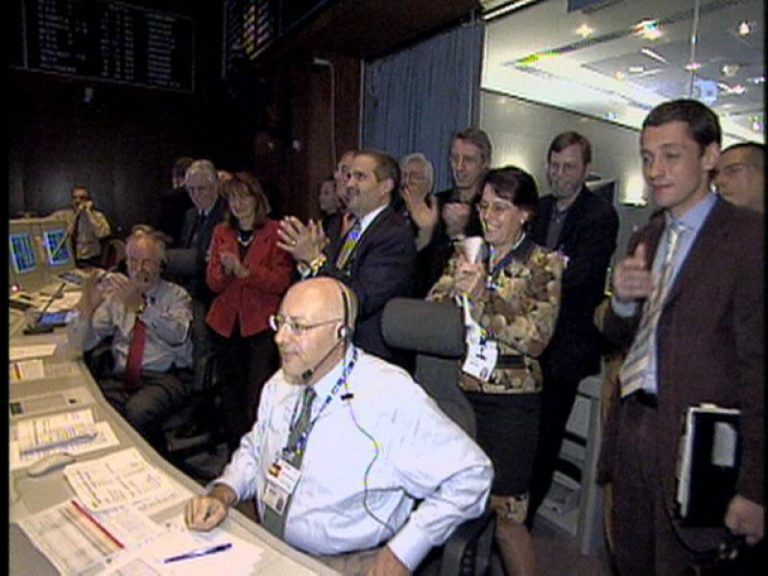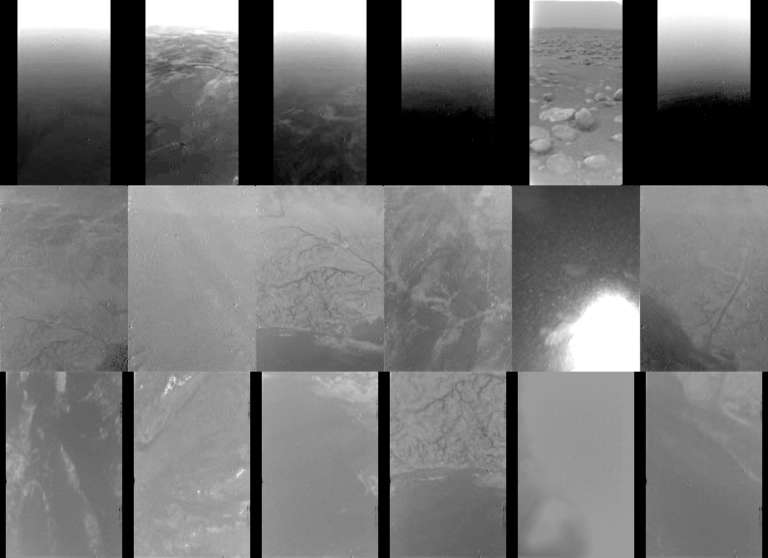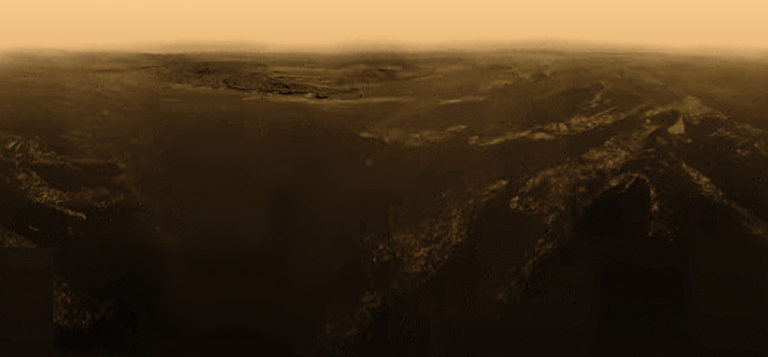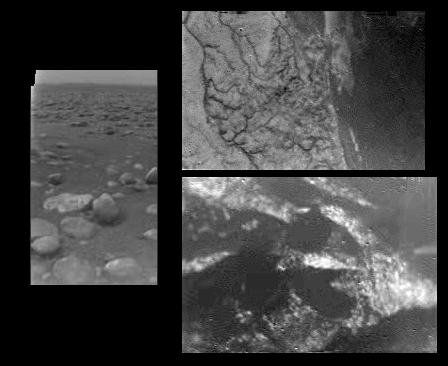Emily Lakdawalla • Jan 15, 2015
Ten years after the Huygens landing: The story of its images
Yesterday was the tenth anniversary of the landing of Huygens on Titan. It was a significant moment for planetary science and a great accomplishment for Europe. But the Huygens landing also stimulated the development of the international community of amateur image processors that does such great work with space images today. I was in the midst of it all at the European Space Operations Centre in Darmstadt.

In January 2005 I was a relative newcomer to journalism. After finishing work on a Society education project I had started to write news articles for our website in the summer of 2004, covering Cassini and whatever else they needed from me, including SMART-1, Venus Express, and any other topic that drew on my planetary geology background. I still wrote like an academic, so depended on guidance and a heavy editorial hand from the Society's Charlene Anderson and Jennifer Vaughn. The Huygens landing would be my first major space event as a journalist.
I was not officially attending as a journalist, however -- at least, that wasn't the original plan. The Society was actually sending me there as a representative to announce the winner of our Titan art contest and to work with the atmospheric science team on producing sounds from Huygens, which we planned to post on our website. But our new Web marketing manager had suggested that while I was there I might try to write a frequently updated, less formal account of the landing, something that she explained to me was called a "web log" or "blog" for short. (I actually used quote marks around the term "blog" in my emails from the time -- how quaint!)
I found the prospect of live-blogging a bit scary. I had no problem with the technical aspect of blogging -- at the time I was hand-coding our Web pages in a text editor, and it would be easy for me to compose and FTP updates to our website quickly -- but I was unsure about having the editorial training wheels off.
So I was wide-eyed and a little intimidated when I showed up at the European Space Operations Centre on Wednesday, January 12, two days before the landing. Working with ESA on the Titan art contest meant my status was different from the rest of the media, and I got VIP treatment including a tour of the mission control areas for all of ESA's active missions by Huygens mission operations manager Claudio Sollazzo. I wrote about that in my first-ever blog entry. Not much happened on the 13th except for a huge formal dinner for the VIPs, which I'd been invited to. I wrote in an email to a friend "I've been warned by the Europeans that these things are long and boring but that plenty of wine is available." They were right about the length and the wine, but I mostly enjoyed the speechifying and the company; there was nothing else to do but talk until Huygens landed.
My landing day live-blog began at 11:50 Central European time on January 14. The Green Bank Telescope in West Virginia had successfully detected Huygens' incredibly faint, 3.5-Watt signal from 1.4 billion kilometers away. The world's radio telescopes continued to listen to Huygens for the many hours of its descent and long survival on the surface, a dramatic story that I wrote up later. But while it was a thrill and relief to know that Huygens was alive and transmitting, what everyone really wanted was pictures. Because Huygens was not expected to survive its landing, all of its data were transmitted to Cassini as it was acquired, in real time. As soon as Cassini set below Huygens' horizon, it turned to Earth and began transmitting the entire data set.
The first packets started arriving at 17:15 local time. Cameras were pointed, live, at engineers in mission control. ESA scheduled a press briefing for that moment. But then the briefing was postponed for 15 minutes. Engineers looked stone-faced. Rumors began to circulate among the gathered reporters that the first packet of data contained nothing but zeroes. But, five minutes after the expected receipt of the data, there was celebration in mission control; good data had started to arrive.

The first complete data set transmission was expected to be delivered to the teams around 19:30. ESA said to allow an hour for the team to process the data, and expect the first image no earlier than 20:30. All of ESOC was at a fever pitch, and the press room was no exception. We were twiddling our thumbs, waiting to pounce on those images when they came out. At 19:57 I emailed my coworkers back at the Society to say "They are announcing something!" At 19:58, I hit "reply all" and wrote: "Never mind. They are announcing dinner." There followed a banquet with lots of speeches to and by political leaders congratulating each other, but no pictures. My fellow reporters were getting increasingly agitated and snarky as the dinner wore on.
Just past 21:00, they finally prepared to show us the first image from Huygens. The big screen showed video of scientists and engineers running into mission control to see the first images. It showed them yelling and celebrating. The camera switched -- to another view of people yelling and celebrating. "Show us the picture!" I remember somebody shouting -- or maybe I was shouting it! Finally, a photo appeared briefly on the screen before it was removed. It was thrilling...and weird. Marty Tomasko, the principal investigator for the Huygens camera, described what he saw there as "drainage channels."
The banquet dinner ended without the images having been released yet. Finally, nearly an hour later, ESA posted three photos to its website. They showed Marty's drainage channels, and a photo of rounded rocks taken after landing, and one that I had a tough time interpreting.
The "drainage channels" image was really, really exciting. But the images were incredibly small. They are embedded in this post at their full resolution. They would never get any bigger; the Huygens camera could only produce these tiny photos, because of the restrictions on data rate imposed by the necessity of transmitting all data in real time. With Huygens' mothership Cassini, the public was accustomed to the rapid release of oodles of high-resolution photos. The fact that only three, very small photos were released from Huygens had the other reporters in the press room grumbling -- and worse.
Reporters around me started to speculate that perhaps ESA had released only three images because they had received only three images. Maybe something horrible had happened, and was being hidden from us. That rumor of packets containing nothing but zeroes -- did it mean that the rest of the image data had been wiped out?
Amidst the grumbing, I got an email from Monica, our marketing manager, at 22:15.
I’m probably not showing you anything you haven’t seen yet, but I found this at Slashdot -
“And now, without further ado or commentary, the DISR Team proudly presents...images from Titan!
UNPROCESSED, RAW IMAGE TRIPLETS FROM THE 3 DISR CAMERAS”
I followed the link -- and gasped. There were hundreds of images, stacked into three-image triplets. Hundreds of views of a new world, never before seen by human eyes. I couldn't believe what I was looking at. Here are just a few of them, a set that I grabbed and emailed out to several of The Planetary Society's Board members, including Wes Huntress, Neil Tyson, and Bill Nye.

But I hesitated to share these with the reporters, much less the rest of the world. The triplets were posted to what appeared to be a camera team website, but the site bore a notice on it: "Before viewing or saving images, please review our legal information section." The legal information page made it seem as if was okay to distribute the images, as long as proper credit was given, but I wasn't sure, especially because ESA had only released three pictures and had stated that there were no further plans to release more until January 21. There was a phone number on the legal information page. I called it...after downloading the entire data set first.
I reached Lyn Doose at the University of Arizona, who was a member of the DISR team. I don't remember the details of that conversation except that he was aghast that the images had been posted. Minutes later, a bit past 23:00, the page was taken down.
But it was too late. Since the page had been slashdotted, the data was already all over the Internet. A mirror was posted at mars.lyle.org/titan. Space enthusiasts all over the world, but especially in Europe, were downloading and playing with the images. The Mars rover fans at unmannedspaceflight.com were playing with the data, and a Belgian enthusiast named Anthony Liekens was collecting and posting amateur-processed versions of the images at his website. I remember particularly liking this one by Rene Pascal:

Other websites were heating up with panoramas and animations of the post-landing images, which appeared to show things moving on the surface (eventually, almost all of this was explained as compression artifacts).
But everyone else in the media center at ESOC was ignorant of all of this. After enduring the speculation about the loss of all the image data for a while, I interrupted a conversation to tell people that in fact ESA had received hundreds of pictures, and I could show them all on my computer. People gathered around, slack-jawed, as they looked at all the data. I told them that the data were not supposed to be public, but that it was all out there. We all debated what to do about these images. They were not supposed to be public, but they were public -- at least in these obscure corners of the World Wide Web. If I recall correctly, most media outlets did not publish these panoramas because of the uncertainty surrounding permission to publish. I didn't post them either.
The next day, January 15, the Huygens team released a preliminary panoramic view taken before the landing, which I posted:

As the probe descended, it drifted over a plateau (center of image) and was heading towards its landing site in a dark area (right). From the drift of the probe, the wind speed has been estimated at around 6-7 kilometers (about 4 miles) per hour.Image: ESA / NASA / University of Arizona
Throughout January 15, I received emails thanking me for my coverage of the landing, but asking me what I knew about the dearth of images. Here's a typical one:
Dear Planetary Society,
I don't want to sound like I'm complaining, but a few friends and I are begining to feel like there is something about the Huygens probe data that's being "covered up". We
wonder why so few images are being let out after the second day and why their resolution quality seems poor compared to images say from the Mars rovers or the Mars Global Suryveror.I know that I just don't know enough about the image processing process that mission scientists have to do to produce these images. I feel that I understand the image
acquisition part, radio bit stream communications parts, and so forth. It's that "the data gets fed to the computers and out comes the images" part of the process that's such a black box to me. What is that they have to do to this data that takes so long?? Why is it so much work for them?Would your staff consider covering this aspect of the process in your next Planetary Report, perhaps as an article? Maybe then it'll put my mind to ease.
No matter what you decide, thank you for all that you do.
Throughout January 15 and 16, amateur-processed images started trickling out into the media. Some of the amateur products were more impressive-looking than the ones that the science team was releasing. There's a good reason for that: amateurs take liberties with the data that scientists do not, blending out seams and fiddling with brightness and contrast to make mosaic tiles match more neatly. The resulting photos look pretty and are great for illustration but are useless for science. Take this gorgeous panorama produced by Christian Waldvogel, which he colorized using the information in ESA's colorized post-landing photo:

I sent another email to Lyn on the 16th, pointing out the website that had mirrored the complete data set and the page containing beautiful mosaics. He told me that the Huygens camera teams in Germany and the U.S. had conferred and decided to go ahead and release the full image data set; ESA posted it on the Huygens website that day. Lyn was clearly upset about the role the University of Arizona had played in the "leak" of the data, though he was not personally responsible; I wrote the following to try to encourage him.
It's a relief to me that the team will be doing this. There was a lot of grumbling that I overheard in the press room (I am learning that reporters are incessant grumblers) about how "ESA just didn't match up to NASA, how they were only trickling out pictures, not letting them all out like they did with MER and Cassini" and even some rumors were going around that only three pictures were released that first night because those were the only three pictures that Huygens had returned. After our conversation, when you were working on having the images taken down, I tried to quell some of those rumors by showing other reporters the pictures that I still had on my screen, to prove that there were indeed lots of pictures available. Hiding information only gives fuel to conspiracy theorists. I know that the science team wishes, after investing so much of their lives in this mission, to have some time to privately investigate their own data and prepare it for publication, but the rovers and Cassini have set a new standard as far as sharing data with the public is concerned. In the long run, sharing the images will serve to engage and energize the public, make them feel a part of the exploration, and make them stronger supporters of space exploration.
I'm hoping also that getting all the images out there might help to distract some attention from the inevitable finger-pointing and blame games that will happen as the media attempt to hunt down those responsible for the Channel A communications snafu.
Originally, ESA and the Huygens camera team had planned to release the first panorama of Huygens images on January 21, a full week after the landing. To my eye, they seemed unprepared for the world's demands for photos. It's understandable that they'd want to have that much time, because of the stresses of landing day and the sudden deluge of data. I visited the "DISR barracks" at ESOC on January 17, and wrote this in an email to a colleague afterward:
I've been over to the room where the DISR people are working today and they are in really sorry condition, they've been working too hard, for too long, following the emotional extremes of Friday, with too little sleep. Marty Tomasko especially, poor guy. Somebody should just go over there and kick them all out of the building for 24 hours!
My sympathies kept flipping back and forth between the science team and the public. The science team was just shattered from lack of sleep and emotional drama (plus, it later turned out, a horrible cold or flu virus that swept through everybody who'd been at ESOC during that stressful time, including me). I completely understood their desire to have just a few more days to make their pictures prettier before unveiling them to the world. At the same time, what was the harm in sharing out the raw images, seeing the amazing work that amateurs could do with them? Why should scientists waste their valuable and limited time creating image products of no science value, when there were hundreds of highly skilled image processing artists around the world willing to volunteer their time to make beautiful images that would show off the mission to its best advantage?
I saw a way to get everybody what they wanted. After returning home, I began to work to advocate for closer collaboration between professionals with space cameras and amateurs with the skill to produce stunning photos from spacecraft image data. By formally, intentionally sharing data and then hosting resulting works on official websites, science teams could benefit from the great skill and freely volunteered time of amateurs while retaining ownership of the image products (in the public eye, even if not in a copyright sense).
To date, I haven't convinced too many missions of this, but both Cassini and Rosetta have featured amateur-processed image products on their websites. New Horizons has involved amateurs in planning "Kodak moment" photos taken at Jupiter, and to be taken at Pluto. The Juno mission to Jupiter has a camera that will depend heavily on amateur processing to produce image releases. In the meantime, I've created an amateur space image library here at The Planetary Society to show off what amateurs can do with the huge supply of stunning solar system image data that all our robotic missions are returning.
Change is slow. I was back at ESOC last November for the landing of Philae, and many moments gave me a feeling of deja vu. But I'm not giving up. Huygens showed me the potential for exciting and engaging the public through the rapid release of raw image data. An excited and engaged public is in the interest of planetary scientists, because those are the people who will write their elected officials to demand more funds for further space missions. I am not aware of any cost to science from the release of the data: no paper denied publication because of photos existing in the media, no outsider scientist beating a Huygens mission scientist to publication of results based on the released images. (If I am wrong on this, I would welcome correction.)
Huygens was much on my mind during the Philae landing. Philae was a great experience, but it didn't top the experience of Huygens. To see that enigmatic orange ball of a world -- to descend into its murky atmosphere and see the clouds begin to part -- to see and recognize those channels -- to know that the same physics makes the same features on Earth and Titan, different worlds built of different materials -- to share and discuss Huygens' images with like-minded enthusiasts around the world -- it was a thrill I'll never forget.
The Time is Now.
As a Planetary Defender, you’re part of our mission to decrease the risk of Earth being hit by an asteroid or comet.
Donate Today

 Explore Worlds
Explore Worlds Find Life
Find Life Defend Earth
Defend Earth


